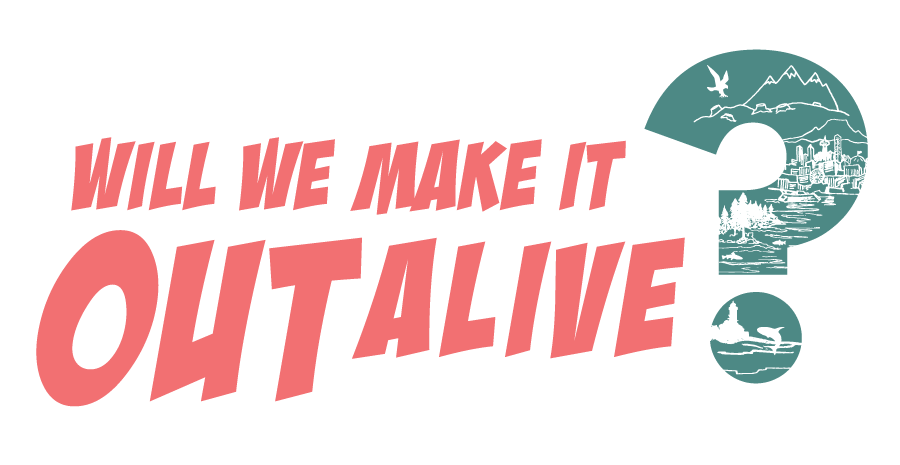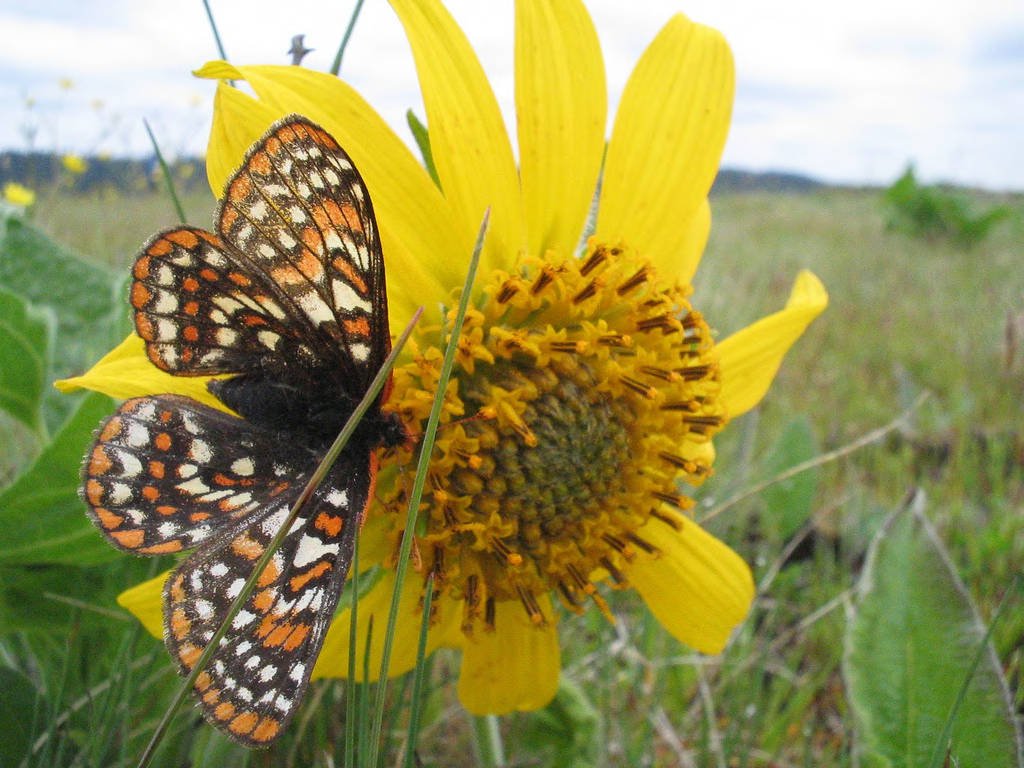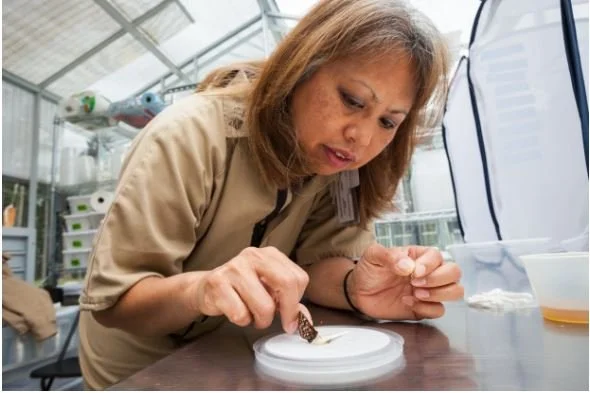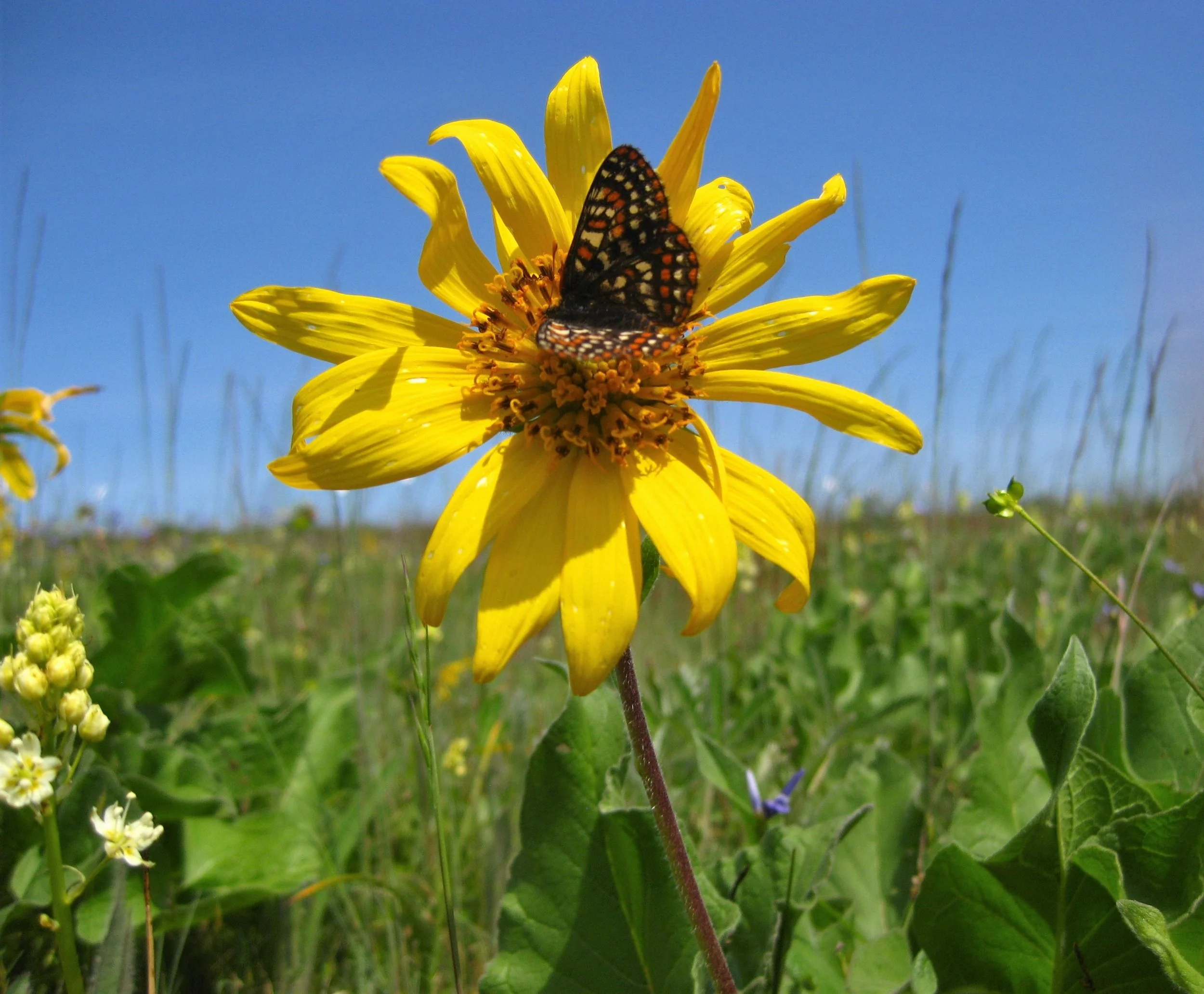S3E5, Why did the Caterpillar Cross the Road? To get to the Artillery Range
/Taylor's checkerspot butterfly, as seen on a flower at Joint Base Lewis-McChord - Photo Credit: USFWS/D. Grosboll
Welcome to Season 3, Episode 5, Why did the Caterpillar Cross the Road? To get to the Artillery Range. A story about the metamorphosis of a prison into a butterfly rearing facility for endangered species recovery. This episode is all about the Sustainability in Prisons Project’s (SPP) Taylor’s Checkerspot Butterfly Program. In this episode, we learn more about the program with Mary Linders, endangered species biologist and we talk with Liz Louie, former butterfly technician, about her experience rearing Taylor’s checkerspot butterflies.
This season is all about the Sustainability in Prisons Project (otherwise referred to as SPP), how they bring education, nature and training into the prisons to reduce recidivism and protect and enhance our environment. This season (we now know) is 7 episodes long. In the first episode we got into how it all started; Episode 2 provided a background on the prison system and an introduction to SPP. Episode 3 was all about partnerships, which is really what SPP is, a network of partners working to bring education and nature into the prison system. Last episode provided an overview of the Conservation Programs at SPP and then we got into more of the details of the Conservation Nursery Programs and how they are involved in prairie restoration.
We start off the episode with a few fun facts, including:
A group of butterflies is called a kaleidoscope, although sometimes referred to as a flutter, flight or swarm. A group of caterpillars is called an army.
According to the Smithsonian: There are about 18,500 butterfly species worldwide (except Antarctica). Of those, around 750 are found in the US.
Interviewees this Episode
Mary Linders
Mary has worked as an endangered species recovery biologist for the Washington Department of Fish and Wildlife (WDFW) since 1994. For the past 18 years she has worked to protect and recover populations of five at-risk prairie and oak-associated species in the South Puget Sound region. As the lead biologist overseeing captive rearing and population re-establishment of the federally endangered Taylor’s checkerspot butterfly, Mary has grown the project from a captive rearing test trial to a program with two captive rearing facilities, 14 field sites, and nine conservation partners. All told, this effort is transforming 1000s of acres of degraded grassland to high quality native prairie benefitting a multitude of other species. Mary holds a Master’s degree in Wildlife Science from the University of Washington-Seattle and a Bachelor’s degree in Anthropology from the University of Wisconsin-Madison.
Liz Louie
Liz is currently the manager of the FareStart Restaurant Program. She was previously a butterfly technician with the Taylor’s Checkerspot Butterfly Rearing program.
According to their website, “FareStart transforms lives, disrupts poverty and nourishes communities through food, life skills and job training.” We hope to have a future mini-sode where we share more about Liz’s experience with the FareStart Program. Stay tuned for more info on that!
Taylor’s Checkerspot Butterfly
According to the WDFW Website:
“Taylor’s checkerspot is a Pacific Northwest endemic butterfly. It is currently restricted to a small scattering of 8 populations in Washington, a single population in British Columbia, and 2 populations in Oregon. The decline of this butterfly has accompanied the loss of open, prairie and grassland habitats…it has declined dramatically due to widespread habitat degradation and loss of prairie-oak ecosystems from development, invasive species, and loss of beneficial disturbance mechanisms. Habitat enhancement efforts for Taylor's checkerspot since 2006 have been significant, however, the amount of fully-restored habitat relative to need is low, and the configuration of habitat remains fragmented and isolated.”
Taylor's Checkerspot Butterfly on Balsamroot - Photo Credit: USFWS/K. Reagan
Taylor's Checkerspot was listed as an endangered species by the Washington State Fish and Wildlife Commission in 2006, the Committee on the Status of Endangered Wildlife in Canada in 2011, and the U.S. Fish and Wildlife Service in 2013. The federal listing means that basically that no harm can come of the butterfly.
Joint Base Lewis-McChord (JBLM) includes the largest remaining intact prairie (which happens to be a live artillery range) in the South Salish Sea Basin. The artillery impact area at JBLM contains some of the highest quality prairies in the Pacific Northwest and some of the few remaining natural populations of Taylor’s checkerspot butterflies. Out of all of the glacial outwash prairie that previously existed there is only 3% remaining and of that, JBLM is home to about 95%.
If you want to learn more about butterfly identification in the South Salish lowlands, check out, A Region Specific Guide to Butterflies of South Puget Sound, Washington.
The Cascadia Prairie Oak Partnership has a lot of great resources related to prairie oak restoration in the Salish Sea basin and Willamette Valley, including various field and landowner guides.
WDFW asks that you share Taylor’s checkerspot butterfly observations on their WDFW wildlife reporting form. Providing detailed information such as a photo and the coordinates will improve the confidence and value of your observation.
Taylor’s Checkerspot Butterfly Program
In this episode, Mary Linders shares more about the Taylor’s Checkerspot Butterfly Program. She talks about their lifecycle and their unique ecological niche within the Salish Lowland Prairies. The ultimate goal of the program is to rear butterflies to be reintroduced into the wild to help restore the few remaining native populations. The easiest way to do that is to try to reduce their mortality in captivity. Mary says that one of the biggest challenges to rearing Taylor’s checkerspot butterflies is weather. On the habitat side, it means that they may or may not get green up after a fire, or germination, which is impacted by weather and management techniques. While on the butterfly side of things, it is very plastic in its behavior to the climate; if there is an early spring, it will shift its flight habits.
We learn that in the wild, the Taylor’s checkerspot butterfly has a survival rate of 1-5% from egg to adult, while in captivity they see about a 65% survival rate. They try to keep every stage at 90% survival rate.
While GPS and GIS have not been used on the incarcerated side, Mary does share how GIS and GPS are used for all aspects of conservation from habitat assessments to recording release locations and tracking movement.
This project is having an impact on species recovery. Where they were down to a single population, they have now established two other populations and there is a third that is doing okay. There are also a couple of sites that have not fully taken off yet.
Mary discusses some of the benefits of bringing a project like this into a prison setting. One of the benefits is that you get an intimate look at captivity and another is that they have been very successful at minimizing mortality in captivity. She says one of the drawbacks of having a program like this in a prison is that it is a very dynamic situation, where you might face lockdowns or other circumstances that might not happen outside of prison. She shares that there was a lot of risk involved, especially at the beginning, since they had to build a dedicated facility, but that the women in the prison took it on and made it their own. One aspect that helped them get this project off the ground, is that the Oregon Zoo was able to help guide the rearing details.
Mary shares how collaborating with SPP has impacted her. She says it’s the ultimate feel good, where you can heal the environment and society at the same time.
Rearing Taylor’s Checkerspot Butterflies in a Prison Setting
Next we talk with Liz Louie about her experience as a butterfly technician. She shares more about how she got started with the program, including going through a traditional interview process, which is not typical for positions in prison. She talks about how she had some skills that were helpful for working with the butterflies, like experience working with data. Liz says that she was fearful at first, because the butterflies are such sensitive little animals! She also shares how it was great to be able to participate through four rearing seasons and that they were able to surpass the prior year’s survival rates.
We ask Liz about the benefits of working in a program like this. She says that every year the technicians had the option to apply for credit from Evergreen. She talks about how impactful it was for those individuals that had never been to college before or had that kind of an experience and that it pushed participants to pursue further education and gave them confidence to apply for other programs.
Liz also explains what butterfly rearing looks like in the prison environment. She talks about the various life cycle stages. She says that the butterfly phase was her favorite part, because you get to handle them a little more and you have to feed them. She also talks about how they have various families or lines and they have to keep track of them so they are breeding different families together.
According to the Oregon Zoo website, this is what their recovery project looks like (they provided guidance to the SPP project):
“Spring: Adult females and eggs are collected in the wild at Joint Base Lewis-McChord near Olympia, Wash., and sent to the zoo for hatching and rearing. The hatched caterpillars are fed leaves grown on grounds at the zoo.
Summer: The caterpillars continue to eat and grow until June when they go into a mostly inactive phase called "diapause." The caterpillars are then placed in earthenware pots in a sheltered outside area and periodically inspected.
Winter: In February the larvae are brought back into the lab where they begin to eat again.
Spring: In March most of the caterpillars are released at sites with suitable habitat to continue growing until they pupate and eclose (or emerge) as butterflies.”
You can learn more about the specifics of rearing in the Oregon Zoo’s Taylor’s Checkerspot Captive Rearing Overview document.
Then we chat about how they make the babies…spoiler alert, she says they did try things like playing some Marvin Gay to see if that helped get them in the mood! Typically they take a single female and place 7-8 males from a different lineage into the same tent. They have run various experiments, such as changing the temperature, or the light, trying to get the conditions prime for baby-time! After a male has, you know, joined…the female is placed in her own tent where she lays the eggs and then she is retired into a mix cage to be released.
The rearing facility is a greenhouse located just outside of the Mission Creek Correctional Facility (well there are two rearing greenhouses now, but there was one while Liz was there). They raise a bed of plantain, which is a weedy little plant that is the preferred food for the caterpillars. The technicians provide the butterflies with a sponge with sugar water, fresh water and nectar bearing plants, such as cotton candy, which they grow onsite. Both caterpillars and butterflies start to wake up in January, then they are fed at the facility for a couple of weeks before they are released into the field in late February.
Liz shares how she thinks prison job programs like this are very important. They provide people with transferable skills that they can use once they are out of prison, but it also provides people with pride and self-confidence to study, learn, and pursue things that they previously thought were not possible. She says that she believes these programs do more good than harm, but she, like others that we have talked with, says that the one thing she wished is that the wages were more representative of the level of work they were completing. For example, she says they only received 35 cents per hour commensurate with other in house jobs (like laundry, kitchen, or custodian), but some of the other physical labor jobs, like for the highway cleanups, incarcerated workers receive a dollar an hour. SPP is working to make it more equitable, but they are working within the legislative confines of current prison wages.
In the end Liz says that she is really glad that she found SPP, and that she is excited to hear that they are growing and offering more and more programs, because she believes it is such a good thing for anyone that participates. Most people have a good experience and they learn a lot.
Until Next Time…
Thank you so much for joining us this episode!
We hope you learned more about:
Taylor’s checkerspot butterfly conservation and restoration efforts and the importance of the South Salish lowland prairies in their recovery
What a SPP facilitated conservation program is like
The impacts of programs like these to species recovery and human enrichment, and how both of these can have a positive impact in our communities
We think one of the takeaways from this episode is that rearing and restoring populations of Taylor’s Checkerspot Butterflies is difficult, and adding it into a prison setting doesn’t make it easier, but the cumulative effort to do so results in benefits to both the butterflies and the humans that participate in the program.
This is another major conservation program that is facilitated by SPP, and while we don’t expect that all of our listeners (or SPP) have the time and resources to develop big programs, there might be someone out there that has just the perfect program idea to pitch to SPP. Next episode, we will learn more about opportunities to participate with SPP without developing a whole dang program.
Please don’t forget to rate, review and subscribe on Apple Podcasts, Google Podcasts, Spotify, Stitcher, or wherever you get your podcasts (like Tune In, Castbox Himalaya, iheartradio, etc). Please let us know what you think in the comments below or on our Facebook, Instagram or Pinterest pages.
Until next time, Will We Make It Out Alive?










